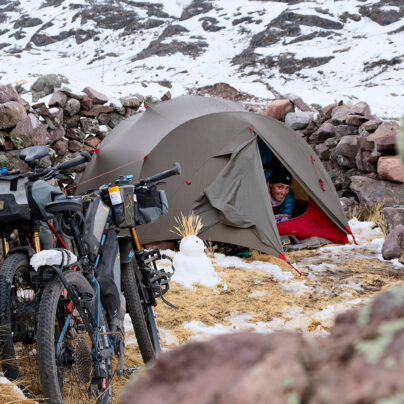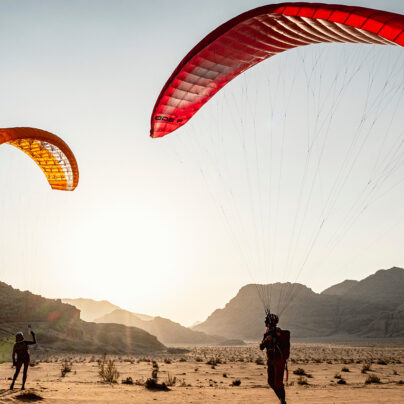The Book of Laughter and Forgetting
Highlining in the Central Highlands of Tasmania
Written by Simon Madden // Photography by Kamil Sustiak
Even under load, walking is solace and a conduit to creativity. The mind drifts in the rhythm of steps and laboured breaths, ideas coalesce as they become untethered from the usual patterns of thoughts.
Below Mt Geryon in the Central Highlands of Tasmania is a pool – the Pool of Memory. It’s said that it remembers everything that is held in its reflection, across the aeons that have eroded the massif. The blurred pattern of the Milky Way wheeling above. The rise and fall of animal kingdoms. The brief, recent, and irrelevant human endeavours on its flanks. Though the water churns and is replaced, the Pool never forgets.
But the best human lives are not cursed with an unfailing memory. The best human lives are full of laughter and forgetting.
Mt Geryon – comprised of two distinct peaks with the free-standing finger of the Foresight rising between them – forms part of the Du Cane Range, a spine of sentinels in the Cradle Mountain-Lake St Clair National Park. The forest on the steep east face thickens into the valley below where one of the world’s great walks, the Overland Track, gives thousands of walkers every year but a taste of the wilds that the region offers.
The area’s grandiose nomenclature draws upon the ancients – the Acropolis, Narcissus, Elysa, Eros, Hyperion. Names that speak of epics and tragedies and knowledge, of civilisation dissolving as you head into the Central Highlands.
Fleeing from civilisation isn’t our goal, though; we are going towards rather than away from something. We are a group of four – two Russians (Stepan and Alex), a Czech (Kamil), and me, an Australian – and we are going to Geryon to walk a highline where no one has before.
To reach the start of the hike we take the boat across Lake St Clair to Narcissus Hut. Thrumming across the water’s surface, ringed by peaks that rise from the bush far in the distance, the journey creates a schism. Between here and there, normality and adventure. After being dropped on the other side we shoulder packs and set off.
Bolting in Australian National Parks is illegal. If officialdom is not enough to halt drills then the designation as a World Heritage Area should. Because of that we would rig natural anchors. Add the need to rock climb to get to potential anchor points and we have a ton of gear: highline rigging, climbing, cameras, camping kit and six days of food. Expedition-weight packs. Stepan is a monster, a testament to youth and a reminder of why Russia won the Eastern Front. He carries 280m of rope in an already overstuffed pack. Desire can be hard to measure, but one way is the size of the pack. Stepan has desire.
‘The harder the project, the more I love it. The more I want it,’ he says.
Even under load, walking is solace and a conduit to creativity. The mind drifts in the rhythm of steps and laboured breaths, ideas coalesce as they become untethered from the usual patterns of thoughts. Here new ideas sprout out of strange memories.
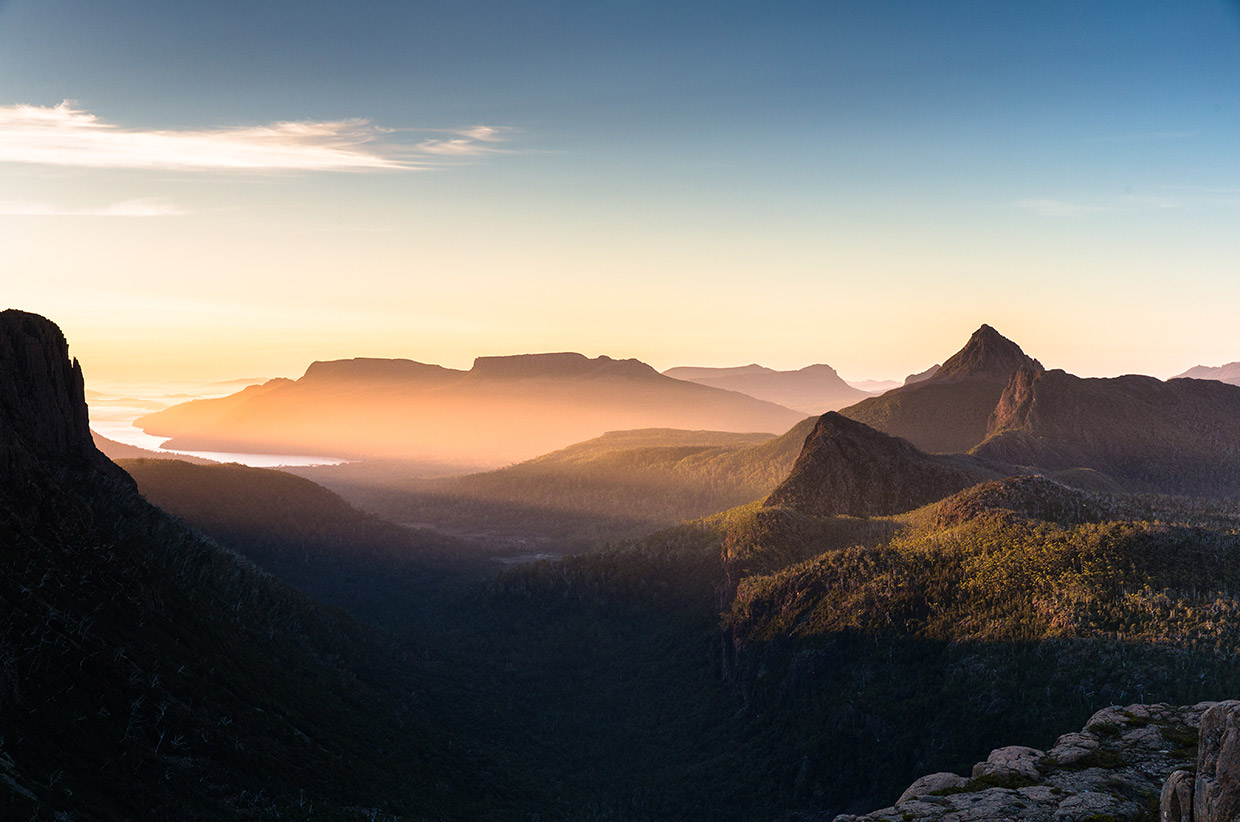
Early on there are small packs and guided groups on the path with us but everyone is walking the opposite direction on the one-way Overland Track. We push against the tide, soon breaking off the main trail to head towards Pine Valley. The crowd thins, then disappears as we pass the hut, and we walk through thick rainforest of pines and Gondwanan myrtles, clinging mosses, more jungle-swamp than anything else. Profound jungle, thick and enveloping, Pandani trees, roots are veins across a ground made up of thousands of years of rotting litter.
The trail shifts abruptly to brutal uphill. Lungs bust. Thighs burn. Loads oppress. These sorts of experiences are an investment in the future – they might be shitty now but they will shine with reflection. Just as abruptly we emerge onto the plateau. The ecosystem shifts, now drier, more open with snow gums and pencil pines lining the track to Lake Elysia, over which Mt Geryon and the Acropolis form a magnificent skyline.
‘The Mt Geryon seems massive from the Lake Elysa and the distance between those peaks looks so long. It looks impossible.’ Stepan voices the fear that darkens uncertainty.
I learn an essential Russian word: blyat – b’lee-ah. It’s pleasing to say, the sounds lolling around to fill the mouth with a thick tongue before briefly hesitating on soft lips. It’s the kind of foreign word that I love. A profanity you don’t need to know the translation for because it can be used in any context; exasperation and excitement alike, expressing defeat, acceptance and joy equally. I say blyat a lot. There is a lot of uncertainty; will the notorious weather break upon us? Will we find natural anchors? Will the distance between them be too great for our gear? Will we fail? Blyat.
On the second day our path goes through the Labyrinth and we are brought back from exhaustion by laughter each time we stop to rest. Small things are hilarious so that big things are ignored. We pass as nothing more than a flicker on the Pool of Memory and climb towards the saddle to the north of Geryon. Tarns dot the stark land up here. Only gnarled shrubs and small trees cling to the rocky ground. When the air is still, it sounds empty and enormous – no birds, no rumbling, no howling.
Mistakes are often easy to declare but hard to quantify, and fortunately small ones are erased under the passage of time. In search of a mythical camping spot at an impossibly beautiful lake we come higher than we had intended and, surprisingly, find ourselves at the final saddle before the start of the climb up to Mt Geryon. We drop all the unnecessary gear and climb to the upper plateau. Up here isolation is not measured in miles as the crow flies – the Overland Track could only be a couple of miles away but it may as well be forever. Subjected to the elements, the plateau is scoured of foliage so that only mounds of ancient and fragile cushion grass survive, looking like bubbles emerging from the ground. We try to step carefully.
The trail shifts abruptly to brutal uphill. Lungs bust. Thighs burn. Loads oppress. These sorts of experiences are an investment in the future – they might be shitty now but they will shine with reflection.
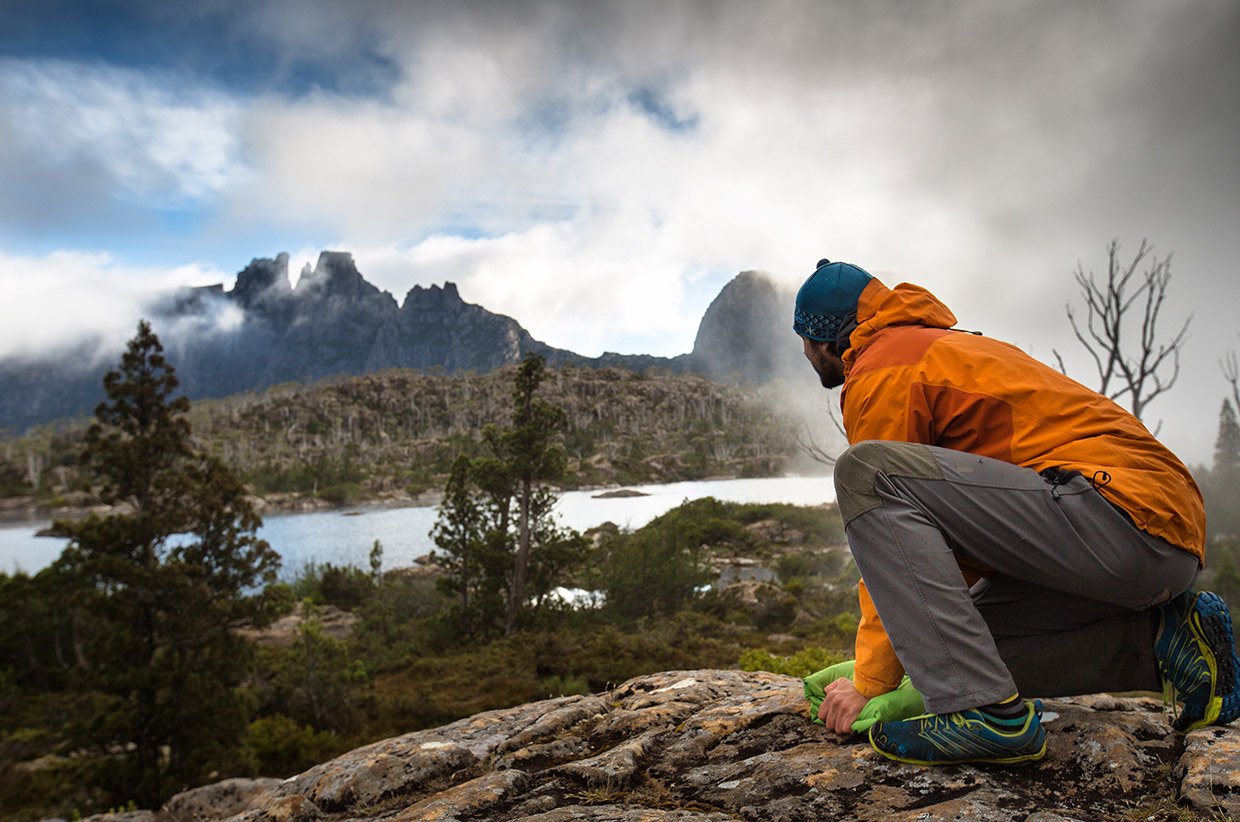
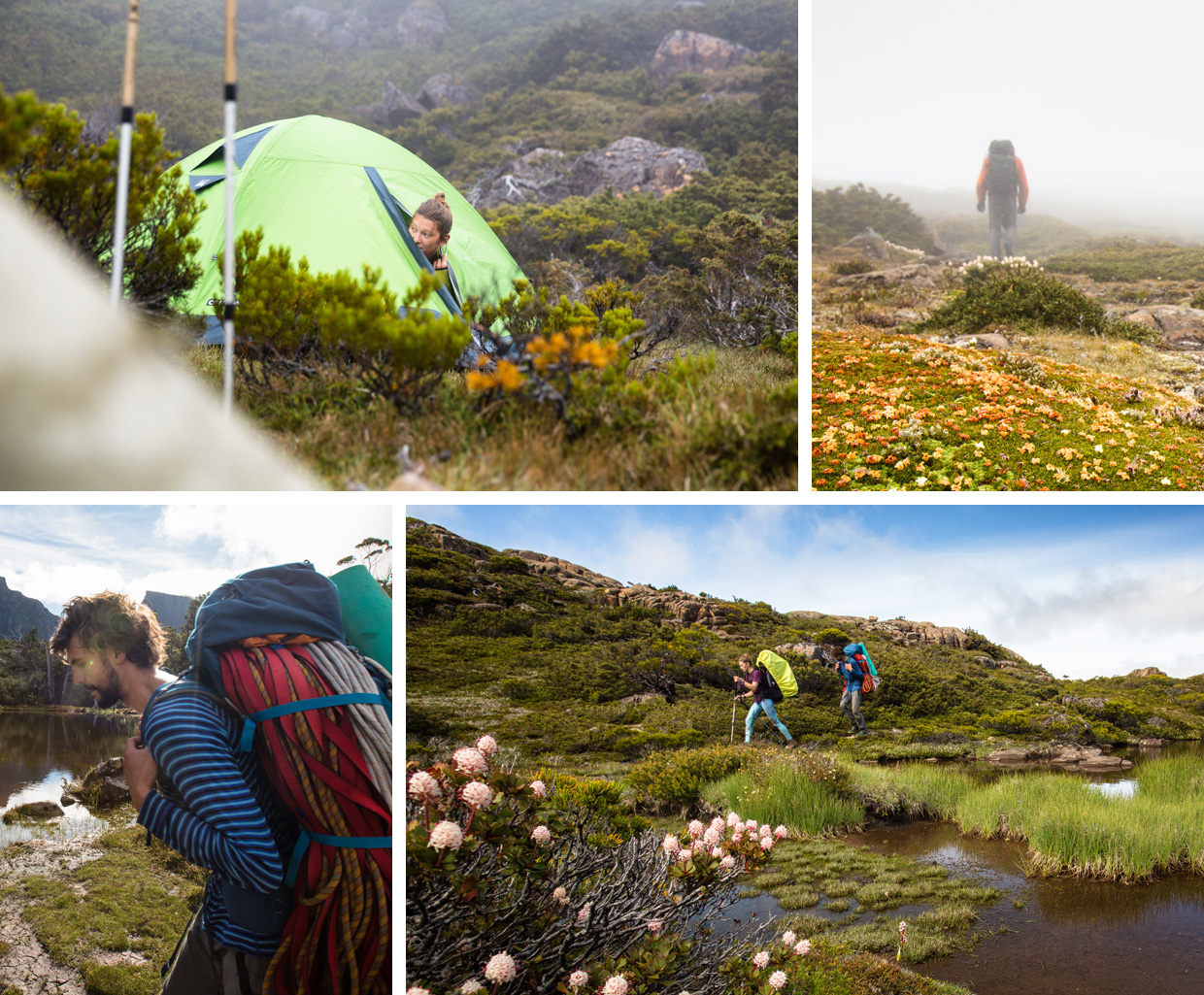
Gaining the north peak requires picking a path amongst a maze of broken boulders so as to sidle under the ridge, before some exposed do-not-fall scrambling leads to the summit. Sheer walls drop away on both sides and the Foresight, a proud pillar of dolerite, rises in the depression between it and the south peak.
Highlining is a question of distance. How far can you rig? How far can you walk? But here it is also an aesthetic pursuit – the line must be beautiful, its position and its aspect, the features it conjoins, the vista it affords.
The measuring laser tells us the king line between the north and south peaks will have to wait, the distance is too great, so we abseil to ledges below the north peak to find suitable anchors at a height equal to the Foresight’s summit. The alpine dolerite, which looked cracked and fissured from a distance, is more fused and blank where we need to secure anchors. But just as spirits are deflating we find a spot about three quarters of the way up the north summit that is level with The Foresight and will take our anchors. Blyat.
With the afternoon drawing late, and after two days of smashing uphill with huge packs, we are tired and so descend to make camp in the security of the saddle. Sleep is often slow to come on an expedition, despite the fatigue. And it is still light deep into the evening in the low latitudes of the Tassie summer.
With the afternoon drawing late, and after two days of smashing uphill with huge packs, we are tired and so descend to make camp in the security of the saddle. Sleep is often slow to come on an expedition, despite the fatigue. And it is still light deep into the evening in the low latitudes of the Tassie summer.
‘Just do the first part of the blink and don’t do the second part,’ is my mumbled advice to a restless Kamil.
The gods of Tasmanian weather are capricious and dawn comes damp and closed in. We wander half-lost through the soupy fog for hours till we reach the notch below the final exposed scramble to the north peak. The rock is slick and perilous. We wait as wind whips the drizzly fog to dampen everything further and, with the weather unmoved after a few hours, we retreat to lower altitudes. A day lost.
The sun breaks through in the afternoon and our camp around a small tarn is spectacular. We sit looking southward down the spine, past Geryon to the Acropolis and Lake St Clair as the sun splashes colour on the craggy peaks. This is the mythical campsite.
Hunger is a function of attention. When you’re moving fast and working hard you forget your stomach but nothing reminds you of hunger like inactivity. As we sit around camp our minds centre on the hollowness in our guts. When dinner does come, eating becomes strategic – eat slowly, tilt the bowl towards you, scrape a single precise layer, study it on the spoon, only then lift it into your mouth. Haste is the enemy. Elongate the time it takes. Hours pass sluggishly until we slither into bed.
Kamil and I awake at midnight to photograph the Milky Way above Geryon – the snaking constellation, the killer of memory. As you stare up at the Milky Way the years dissolve. The stars didn’t care that as it rolled on from 11:59pm, it was my birthday but all the years were gone.
Forgetting has always been part of time’s flow but now it’s harder to forget than to remember. Digital memory imprints things forever in vast data collections – pictures and posts and records of things perhaps better left to fade. Google knows more about us than we can remember ourselves and this sort of perfect memory is a panopticon’s curse, altering our behaviour, causing us to self-censor. An over-full past is also muddy; it’s hard to focus on what is important. Forgetting helps us evolve and change, and forgiveness involves forgetting. A good ‘forgetory’ is as important as a good memory and we have to ferment the conditions for forgetting.
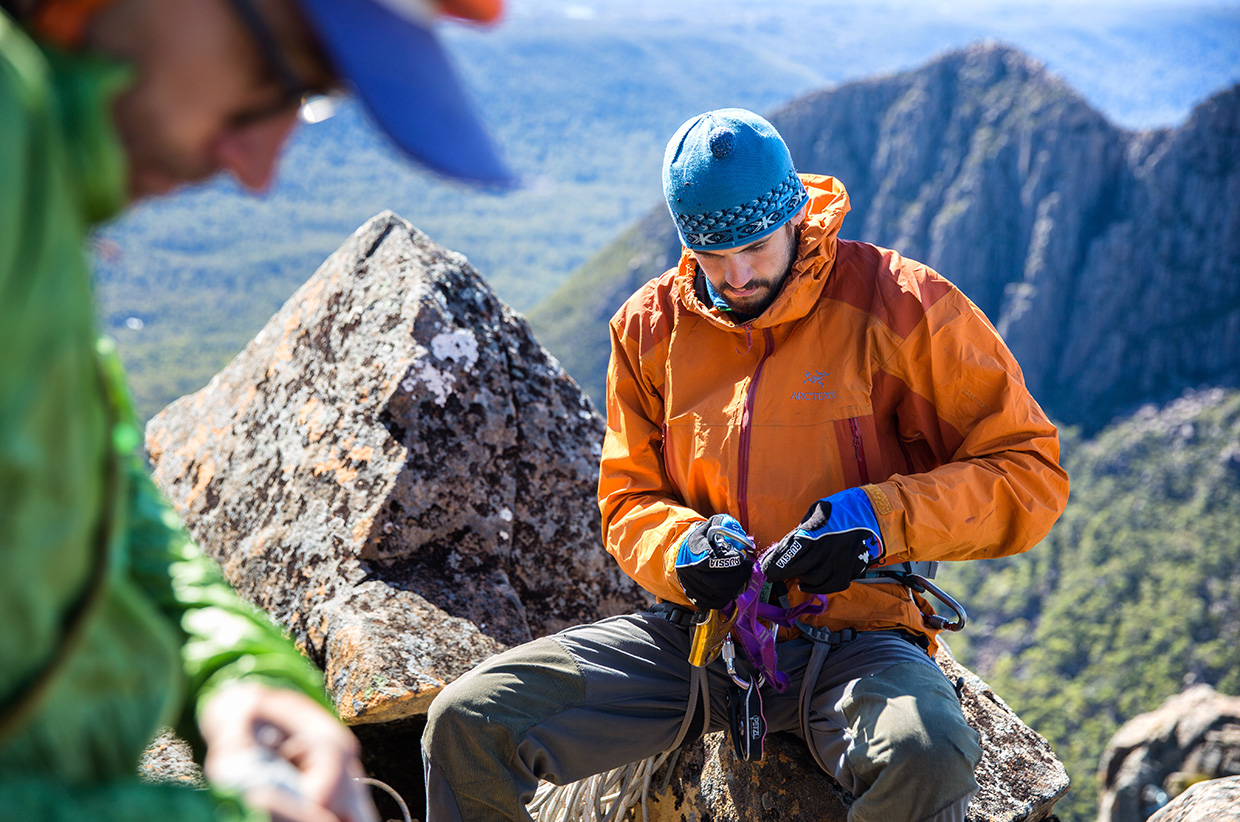


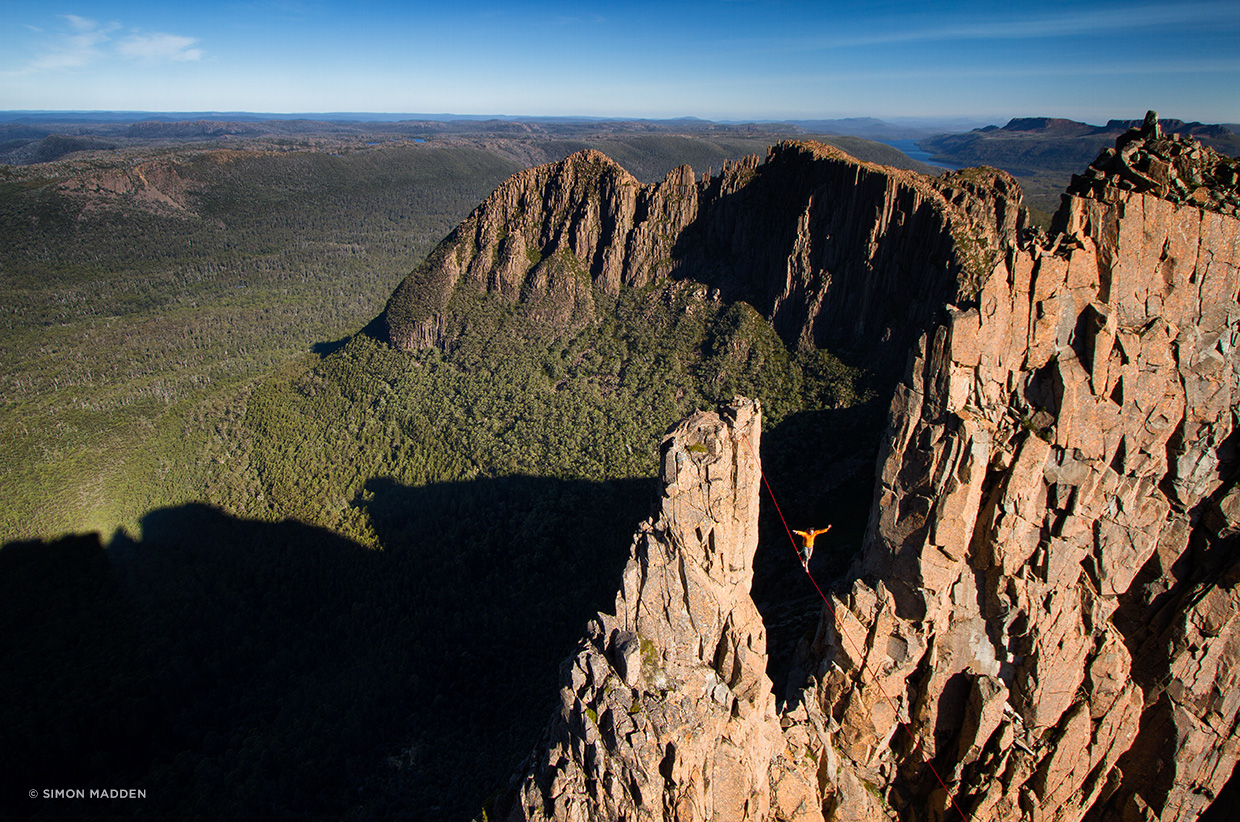
The next day – the 9th of January – happens with powerful momentum. We ascend to the summit. As Alex and Kamil work on the north peak’s anchors, I abseil into the notch and climb the Foresight above the yawning east face, bringing Stepan up on second. As we wrap static rope around the broad stack, the wind whistles and whips through the breach that separates us from the north peak. The walking line arcs through the air, at the mercy of the gale, as we drag it across to us. By luck or skill the line isn’t twisted – with no second chances it would have been terminal. We tension the line and Tyrolean the 47m back to the north peak anchors. The rigging is complete.
The Russians have a ritual; Alex would make the first attempt. The line flicks and hums. ‘During highlining it’s difficult to remember what you are thinking about. Sometimes it is like dreams, you have it but you don’t remember.’ Her words. Our time is too short, the line too long, the exposure too great. She struggles to make progress and the rest of us sit soundlessly and watch.
I can see the confidence in Stepan draining as he ties into his leash and hand-over-hands into the middle. He tests the line a few times, standing to his feet and sitting again. The distance seems to grow.
Memories are not stable – they change, don’t stay fixed in consciousness. And you can deliberately get rid of them. Scrape some of them off. Walking the line is amnesia. Forgetting the trudge, burnt calves and charred quads, weather squalls, poor decisions, sharp moments of hostility; the humdrum life off the mountain, the past, plans, the self. The challenge and the instant visceral feedback consume consciousness. Walking the line is self-administered amnesia.
Maybe the question, then, is not what do you remember of walking the line. Maybe the question is what do you remember of your self?
The wind, already strong, becomes enraged. The line whips and cracks with a confoundingly simultaneous tension and looseness but Stepan holds fast, somehow. Doing battle with the anthropomorphised elements, just as the ancients did, he expels three mighty breaths I can hear above everything and from where I stand it is as if these push back the wind itself. Defiant, he walks the line.
Some things sear themselves across your memory, a hot slash. Not everything is forgotten.
Highline Credits:
The Book of Laughter and Forgetting
Česká republika — Россия – Straya
Riggers: Kamil Sustiak / Simon Madden / Alex Bog / Stepan Novikov. First Ascent: Stepan Novikov, 9th of January, 2016
Simon Madden – a writer, photographer and filmmaker based in Australia – is a director of Adventure Types. He has climbed rocks and skied all around the world but is probably best at carrying heavily laden packs up steep hills.
Website: www.adventuretypes.com
Twitter: @SPPMadden
Kamil Sustiak is a photographer and filmmaker from the Czech Republic currently based in the Blue Mountains, Australia. He loves remote expeditions for the opportunity to capture images of great human endeavour in astoundingly beautiful places.
Website: www.kamilsustiak.com
Twitter: @kamil_sustiak
Instagram: @kamil_sustiak
